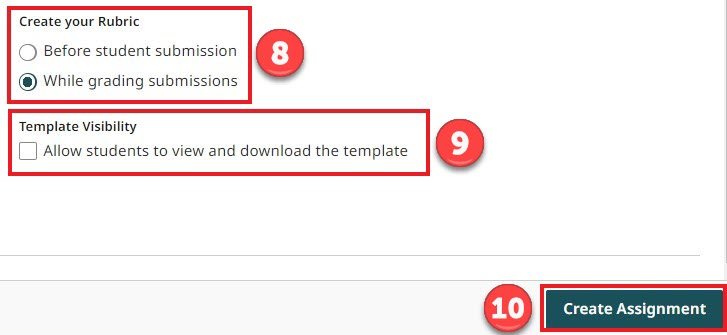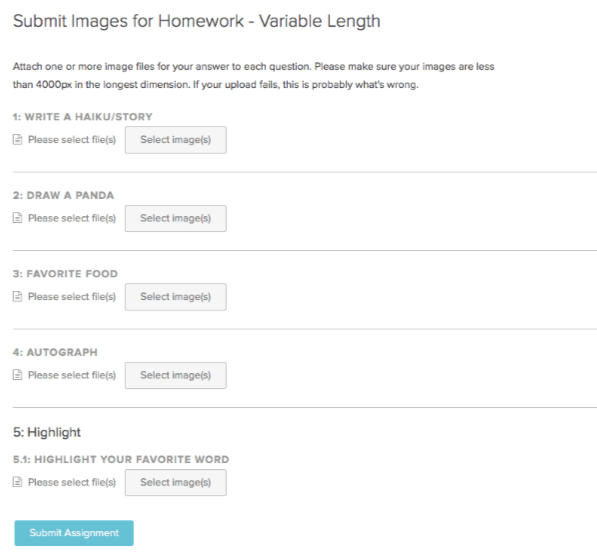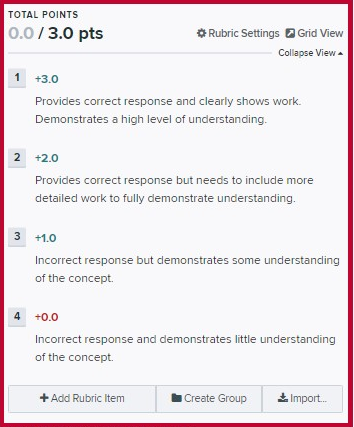About Gradescope Homework Assignments & Problem Sets
Gradescope offers instructors the option to upload and evaluate homework assignments and problem sets. Completed assignments may be batch-scanned and uploaded to Gradescope by the instructor or uploaded by the students themselves.
Note: CCS offers scanning services for single page (single or double-sided) bubble sheets only. The CCS Gradescope Bubble Sheet Scanning Service is not available for homework assignments. If you want to collect and scan student assignments to upload to Gradescope, you must use a personal scanner or your department’s scanner.
Compared to CourseLink’s Dropbox tool, Gradescope’s Homework Assignments allow for more rapid evaluation and collaboration amongst graders, while allowing for either student or instructor uploads. Another notable optional feature of Homework Assignments is regrade requests. Students may submit regrade requests – with justification required – for individual questions if the option is enabled.
Gradescope Homework Assignments overview document (PDF).
When Should I Use Gradescope Homework Assignments?
Gradescope Homework is ideal for take-home assignments or problem sets, especially for assignments that require handwritten work (e.g., showing work to solve a math problem or drawing a diagram/graph). A unique feature of Gradescope is that graders evaluate a single question across all submissions before moving on to the next problem. This allows for greater consistency between evaluators’ comments and more efficient team assessment.
Check out the Office of Teaching and Learning’s Teaching with AI Series presentation on Gradescope [June 2024].
Gradescope Homework Assignment Process
Create a Homework Assignment
Instructors have two options to access Gradescope Homework – via CourseLink Integration (Content Tool) or directly through gradescope.ca using Single Sign On.
To get the most out of Gradescope and to ensure that your Homework & Problem Sets assignment is synced with your CourseLink site’s Classlist and connected to a corresponding grade item, it is recommended that the assignment be created through the integration. Please view our resources for Gradescope’s CourseLink Integration to learn how to create your assignment.
Once the assignment is created via the integration, it can be accessed through the link created in your course site’s Content tool, or by logging in via SSO at gradescope.ca using their School Credentials option.
Settings Options for Homework
Enter a name for your assignment.
Upload a template file as a PDF. Gradescope provides further information on the template file on their support site.
Submission Anonymization can be enabled at the assignment level to replace student names and numbers with a randomly generated text identifier, preventing graders from identifying the identity of the student being assessed. Further information on submission anonymization is available on Gradescope's Help Centre.
Select who will upload submissions - instructor (default) or student. **Note:** If you select **student**, you will be prompted to add a release date, due date, and submission type. Further information on submission types is available on Gradescope’s Help Centre.
- Select a Release Date and a Due Date and select Allow Late Submissions (if applicable).
- Choose the **Submission Type:**
- Use a **Variable Length** submission if students can submit an unlimited number of pages. This type is ideal if the assignment requires longer, written responses or allows students to submit notes or scratch paper. Upon submission, students need to match the questions to the pages with their relevant responses. For student-uploaded variable length submissions, they may submit either one or more **individual images **per question or a single PDF file for the entire assignment. When submitting a **single PDF file**, they will be prompted to indicate which page of the PDF file corresponds to which answer.
- Use a **Templated (Fixed Length)** submission if the responses will be in static locations. This type is useful for worksheet submissions where students are filling in blanks or answering questions in designated boxes. For student-uploaded templated (fixed length) submissions, they may **only upload a single PDF file** for the entire assignment.
7. Choose whether Group Submission is enabled, and indicate if there is a maximum group size allowed. Group Submissions allows one member of a group to upload a submission on behalf of the entire group, and assign group members to the submission. All group members receive the same mark and feedback. Further information on how students utilize the group submissions feature is available on Gradescope's Help Centre.
- Under Assignment Settings, you may also choose when you will create your rubric: before student submission or while grading submissions.
- If you would like students to be able to view your uploaded PDF, be sure to check the box under Template Visibility.
Note: For instructor-uploaded assignments, students will never see the template file or any other part of the assignment until grading is complete, and you click Publish Grades. - Finally, click the Create Assignment button.
Edit Outline
From the Edit Outline page, you can add question titles, sub-questions, and point values, if desired. More information on this process can be found on Gradescope’s Creating an Outline page.
Add Extensions
In cases where students are scanning and uploading their work, Gradescope provides the ability to set alternative release dates, due dates, late due dates, and time limit extensions at the assignment level. Please visit the Gradescope Help Centre’s Extending dates and times on an assignment resource for more information.
If you are running multiple timed exams or quizzes through Gradescope with student submissions enabled and you need to provide extended time across all assignments at the course level (e.g., students with time-and-a-half, or double-time conditions through Student Accessibility Services [SAS]), Gradescope provides that option as well. Please visit the Extending Time Limits at the Course Level page on the Gradescope Help Centre site for more information.
Homework Submission
Student Uploads
- Students may access Gradescope either via the CourseLink integration or directly through gradescope.ca. From CourseLink, students select the assignment and are redirected to the assignment on Gradescope. From Gradescope, students select the course, then choose the assignment.
- If the assignment type is templated, students have two options to upload their assignment: submit images or submit PDF.
If the assignment type is variable, students will only have the PDF submission option.
Option #1: Student submits images
Students take pictures of their assignment and upload an image file(s) for each question.
Option #2: Student submits PDF
If the submission type is set to Variable Length, students are prompted to match each question to the corresponding page where the answer is found. If the submission type was Templated (Fixed Length), students simply upload their PDF.
3. Upon successful submission, students will receive a confirmation email. <br/> **Note: **Students may scan their work and save them as PDFs. However, if they do not have access to a scanner, they may take images with a mobile device such as a cell phone and convert them from image formats to PDF prior to upload. More information on this process can be found on the Gradescope Help Centre’s Scanning Work on a Mobile Device page
proxy uploads
Instructors and TAs have the option to submit assignments on behalf of students. This feature is useful in cases where students miss the submission date and email the instructor their files instead. Proxy submissions permit late uploads even when the assignment does not allow late submissions from students.
- On the Manage Submissions page, select the Upload Submission button at the bottom of the page.
- From there, choose the student from the drop-down menu, select their file from your computer, and click the Upload button.
Grade the Homework/Problem Set
- Select Grade Submissions from the lefthand toolbar.
- Select the name/number of the question you wish to begin grading or click the Next Question button.
Gradescope Rubrics
Gradescope rubrics allow instructors and TAs to grade quickly and consistently, applying the same set of feedback to every submission. Gradescope rubrics are created for each individual question.
The main type of rubric used in Gradescope is the List View Rubric, which is made up of one or multiple Rubric Items, displayed in a vertical stack. Rubric Items contain a number of points as well as a description for the point value.
Gradescope recently introduced an option for Grid View Rubrics (beta), which are more traditional matrix style rubrics that allow you to add rows and columns of points and criteria to your rubric. As this is a beta feature, please note that you will need to request it be enabled for your Gradescope site by contacting help@gradescope.ca (be sure to include a link to your Gradescope course, not to your CourseLink course site).
Gradescope’s Help Centre provides extensive resources to help instructors and TAs with rubrics, including:
Creating a rubric and grading with it
Includes: Importing rubrics, item groups, and keyboard shortcuts.
gradescope annotations
Gradescope’s annotation tools allow graders to mark up a student’s submission. Students can see these marks, which can help them identify what part of the submission focus on. Annotation options include text boxes, pencil markups with multiple colours, a box tool, and stickers which include stars, checkmarks and X’s. You can also use LaTeX to add math symbols to comments, text annotations, answer group names, and regrade requests and responses.
Gradescope’s Help Centre provides the following resources to assist instructors and TAs with annotations:
Review/Release Grades
Once you are finished grading submissions, the Review Grades page provides an overview of what was graded and allows you to:
Publish grades and feedback for student review
Includes an option to notify students via email that grades/feedback are available
Post grades from Gradescope to CourseLink via the integration
Note: If you do not want students to access the quiz template, grades, or feedback through Gradescope (e.g., for a final exam) do not publish the grades in Gradescope. You can still use the Post Grades to CourseLink option to push the scores to the associated grade item via the integration, even if the grades are not published on Gradescope.
hiding rubric items
By default, all rubric items are shown to students. However, in some cases it may be preferable to hide all or part of the rubric from students. You can change this from the Assignment Settings page.
For more information on the options available for showing or hiding rubric items, please visit the Gradescope Help Centre’s Hide rubric items resource.
regrade requests
Regrade requests allow students to submit short statements about why they think their work should be given another look.
Regrade requests are enabled by default for all published assignments. However, they can be disabled by following the steps below:
- Access the Regrade Requests feature from the lefthand toolbar.
- Here you can enable/disable the feature.
For a more detailed look at how Gradescope’s Regrade Requests feature works, please visit the Managing Regrade Requests page on Gradescope’s Help Centre.
Access Data and Statistics
Gradescope provides data and statistics for Programming Assignments on two levels:
Assignment Statistics
The default view showcases the averages from each question. Clicking a question’s bar within the chart will focus on it, updating the stats under the chart.Question Statistics
If you click a question in the table below the chart, you can see that question’s statistics, showing you how often each rubric item was applied. This allows you to pinpoint difficulties or concepts that students struggled with.
More information on these options is available on the Assignment and Question Statistics page of the Gradescope Help Centre.
Useful Tips:
To ensure the best possible AI-assisted grading experience, follow Gradescope's list of recommendations including:
Upload an entirely blank assignment template.
Make sure your template is identical to the one you distribute to students.
Leave some space between your questions, so that the region boxes on your outline don’t overlap.
Related Videos
Related Programming
Gradescope Online Drop-ins (Tue. 10 AM / Wed. 2 PM)
Weekly Online Workshop: Get Started with Gradescope (Thu. 12 PM)
Introduction to Gradescope (03/03/2022)
Introduction to Gradescope Homework Assignments (03/21/2022)
Gradescope for Assessment of On-Paper Assignments and Tests (06/16/2022)
Transitioning from Crowdmark to Gradescope for On-Paper Assessments (06/28/2022)
Other Gradescope Assignment Types
Other Gradescope Scenarios
Gradescope Support
Additional Support information for Gradescope can be found on our Gradescope Support page.
If you need further assistance, please contact CourseLink Support.

























